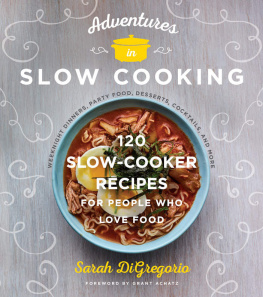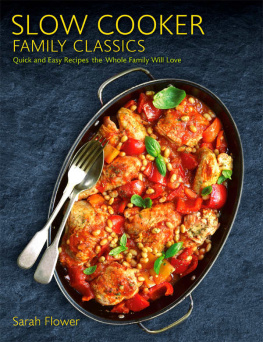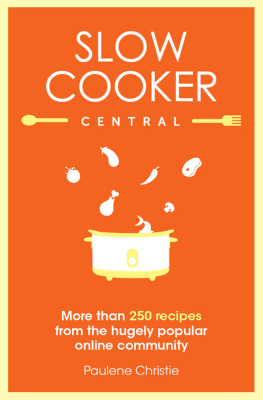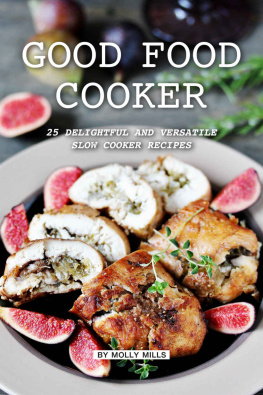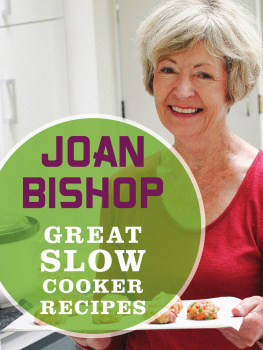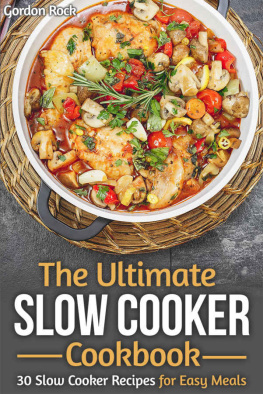
For Amol and Mira,
who were willing to
share one small Brooklyn
apartment with six slow
cookers. Youre the best.
I love you.

Contents
Guide

S low cookers have baggage. Theyre associated with 1970s cooking, beef stew and pot roast, chili and casseroles. So maybe its a surprise to find my name here, a modernist chef writing a foreword to a slow-cooker book.
It shouldnt be. In the top-tier restaurant world, we are all about slow cooking. Sometimes the technique goes by another namelike sous videbut the idea is the same. Gentle, low, long cooking. The slow cooker can bring the depth of flavor, rich textures, and aromas found at the best restaurants into your home kitchen.
Ill give you an example. At my restaurant Next, we re-created the French Laundry menu from one night in 1996 when I ate there with my father. And one of the iconic canaps that we included was Thomas Kellers truffle-infused custard served in an eggshell with a potato chip on top. We actually used a slow cooker to steam the custards. Because theres no better way. We have so much technology in my kitchens, but at the end of the day, sometimes the best way to do something is with a fifty-dollar slow cooker from Amazon.
Its not a thermal circulator. It doesnt cost a fortune. But it is a very useful tool in the modern kitchen. Just because it was popular with your parents in the 1970s and 80s doesnt mean it doesnt have a place in modern cooking. Historically, when you look at gastronomy, some of the best dishes in the world are items that are covered and cooked slowly, bubbling away.
Tools are tools, and once you know what a slow cooker does wellsteaming, acting as a water bath, braisingyou can use it in a regimented way to great effect. It reminds me of when I started at the French Laundry in 1996, soon after that memorable dinner with my father. I got to my station and there was a microwave there. I recoiled; I thought this is terriblebut of course it wasnt. You have to remove your value judgments and think about it as a tool, nothing more. The only relevant question is, what can it do?
To bring the slow cooker into the modern kitchen, you should be conscious of the order in which you add ingredients. The old idea of throwing everything in the pot at once and walking away generally isnt going to result in great food. Long, slow cooking will mellow flavors, so in many cases, adding more herbs, spices, or acid toward the end of the cook time will wake up the food, and the aroma of those ingredients will be intense, activated by steam. Throw in a bouquet of thyme or rosemary in the last twenty minutes of cooking, or finish a dish with spices infused in butter. Those aromatics will perfume the whole dish in a potent way, blending the long-cooked with the immediate, and thats an amazing thing.
Whats fair game? Everything that benefits from being cooked to tenderness. That includes vegetables, which are often overlooked by slow-cooker cookbooks. But think about fennel cooked in olive oil until its melting and sweet, cherry tomatoes caramelized in their own juices, or eggplant braised in harissa and honey. Whole grains can be steamed in the slow cooker or simmered with other ingredients for a risotto or ragout. And theres no better way to make silky custardsboth savory and sweetthan in a slow-cooker water bath.
So let go of your preconceived ideas about slow-cooker cooking and let this book be a guide as you seek to answer that central question, the only one that matters: What can this tool do?
Grant Achatz
I n some corners of the food media world, where I worked until I started this book, theres a low-level snobbery about slow cookers. I was guilty of it, too. So many slow-cooker recipes seemed to promise more than they could deliver or were stuck in Condensed Soup Land. For me, that changed when I worked on a story about slow-cooker recipes for Food & Wine with Grant Achatz. (He was kind enough to write the foreword to this book.) Listening to him excitedly rattle off all the dishes a slow cooker could make (barbacoa and steamed British pudding; whole grains and dumplings!) made me really excited to go home, dust off my slow cooker, and take it for a spin. I made perfect polenta without stirring once, and then a velvety pot de crme, and I was hooked.
The idea for this book came out of those conversations with Grantand specifically, the sense of excitement that came with them. Whether youre a slow-cooker skeptic or someone who uses a slow cooker all the time, what I would most like to convey is that sense of funthe joy of tinkering with this underestimated gadget.
This is a slow-cooker book for people who love to cook. Its not all about getting out of the kitchen as quickly as possible at any cost to the finished dish. I love being in the kitchen, and I want to use my (sometimes limited) time there efficiently and well. Some of the recipes in this book are fast and easy, some are one-pot meals, and all of them are realistic. But with a few exceptions, Im not a fan of setting and forgettingby which I mean putting raw ingredients in the slow cooker and then eating them ten hours later without doing anything else. In most cases, dishes cooked that way will be underwhelming; theyll lack vivid flavor and texture.
So youll notice that most of these recipes have steps to take before you slow-cook and then just before you eat that build layers of flavor: Saut aromatics before you go to work, for example, or broil before serving to add caramelization. Simple techniques like those can make slow-cook dishes taste as vibrant and alive as the food you cook on your stovetop. Often, these upgrades take a matter of minutes. (And if you need a set-it-and-forget-it recipe, I suggest duck confit, which is just about the easiest, most forgiving dish in this book.)
Some of these recipes can cook (or can hold on warm) all day or all night, and Ive marked those for you so you can find them when you need them. But some of them cook for only a few hours, because Id like to broaden the way you think about your slow cooker. The ability to cook unattended for eight to ten hours is just one of the slow cookers advantages. Pour a little water into the bottom and its a bainmarie, or water bath, perfect for gently cooking custards. (Ill never make a custard any other way ever again.) It saves a burner during the holidays; it cooks without heating the kitchen in the summer. It uses far less energy than the oven, and it can steam a perfect batch of whole grains while youre on a conference call. It creates a cooking environment thats dense with moisture, trapping flavorful steam almost like a tagine. Wrap a big hunk of chile-rubbed lamb in banana leaves, and the slow cooker will braise it as slowly and gently as an earthen barbecue pit. And, yes, it can make pho and cassoulet and polenta and congee while youre at work.

Ive tried to walk a line between excellence and expediency throughout, which is a line I think we all walk all the time. Sometimes you plan a dinner party for fun and sometimes you just need a supersimple dish of beans and kale on a night when youve worked late. The mix of recipes is designed for real life.
Next page
